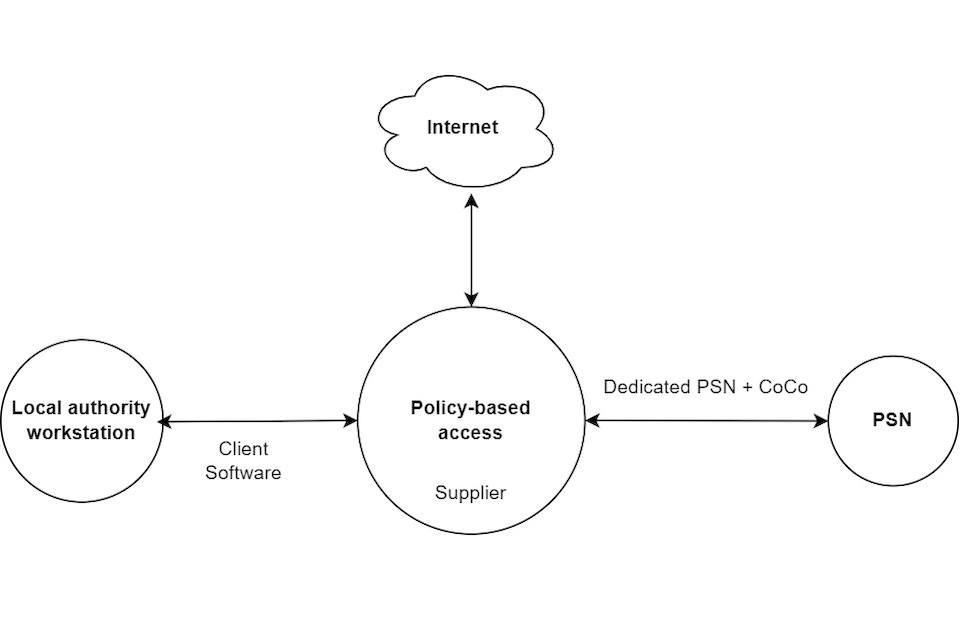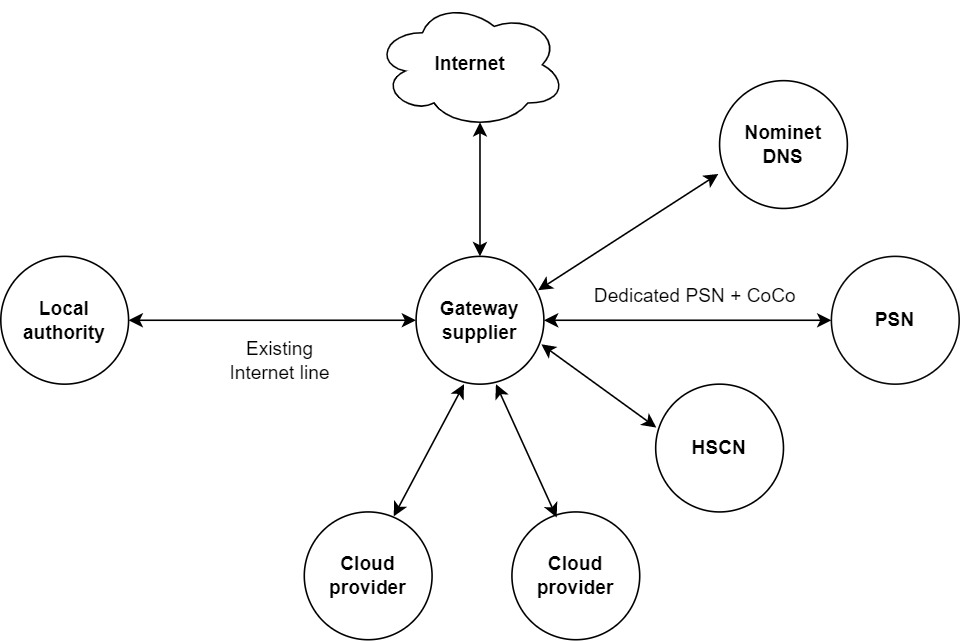Future Networks for Government (FN4G)
FN4G is the Cabinet Office programme set up to help organisations move away from the Public Services Network (PSN)
The Public Services Network (PSN) is a legacy network which is increasingly hard to secure. Organisations should migrate to modern network solutions, which offer more competitive commercial terms, greater flexibility and scalability.
When you choose modern solutions they should be appropriately secure and follow:
-
the Technology Code of Practice (TCoP)
-
legal, regulatory and policy obligations like the UK General Data Protection Regulation (UK GDPR)
Programme scope for financial year 2022 to 2023
FN4G coordinates and reports on organisations’ plans to migrate away from the PSN. The programme is evolving its proactive strategy to identify and promote modern network architecture. These options offer improved security while also supporting public sector organisations to migrate away from the PSN.
In most cases, local authorities use on premise infrastructure to run a dedicated line directly into the PSN. Organisations have to:
-
maintain that infrastructure
-
pay for the line on a contract basis
-
pay for a DNS contract
Alternative ways to connect to the PSN ecosystem
FN4G has set out a range of technical concepts providing 4 alternative ways to connect to the PSN ecosystem:
-
Desktop as a service
-
Shared access to PSN (SAP)
-
Tunnelled access to PSN (TAP)
-
Gateway access to PSN (GAP)
1. Desktop as a service
The local authority (or other PSN users) could buy a pay-as-you-go remote desktop service, which has virtual computers linked to the PSN. This option is secure, relatively easy to deploy and avoids vendor lock-in with inflexible, lengthy contracts.
Diagram 1

Diagram 1 shows the supplier infrastructure with a virtual desktop. This infrastructure enables traffic to and from the internet with traffic to a local authority or other user. A secure remote desktop protocol connection with certificate and multi factor authentication is set up from the supplier to the local authority. The virtual desktop has a dedicated connection to the PSN as well as a Nominet DNS connection.
2. Shared access to PSN (SAP)
This option is good for PSN users who already have an existing connection, for example the Health and Social Care Network (HSCN). The existing network connection is used to carry all PSN traffic as well, which is split once it reaches the supplier.
Diagram 2

Diagram 2 shows the local authority connected to a supplier network via an existing HSCN link. The supplier network has a dedicated connection to the PSN as well as a connection to the HSCN.
3. Tunnelled access to PSN (TAP)
This option involves installing a piece of client software on each device which uses policies to route traffic to different places. TAP requires administrative overhead, but achieves zero trust. It’s a good option for PSN users who can use their existing investment in zero trust.
Diagram 3

Diagram 3 shows the supplier has policies to route traffic to different destinations. For example, to the local authority workstation via client software, to the PSN via a dedicated line or to the internet.
4. Gateway access to PSN (GAP)
A PSN user could pipe all of their traffic to the supplier, who would then provide a full unified threat management service. This solution is scalable and provides full access to users. It’s highly secure, achieves close to zero trust and provides full transparency on usage and costs.
Diagram 4

Diagram 4 shows that a user, for example a local authority, has piped all its traffic to a gateway supplier. That supplier manages the exchange of traffic for everything, for example to the internet, Nominet DNS, the dedicated connection to the PSN, to HSCN, to cloud providers.
Benefits of these alternative PSN solutions
The availability of these solutions results in more supplier choice in how organisations access the PSN. Organisations can transform their digital programmes and:
-
simplify their infrastructure
-
reduce technical debt and network sprawl
-
spend budgets more effectively
-
improve security posture
Reasons for our programme strategy in 2022 to 2023
We have identified these alternative technical options, enabling indirect access to the PSN, while organisations are migrating off the PSN. We believe local authorities in particular will benefit from these options while they’re waiting for central government applications to migrate away from the PSN.
In addition, there is a need to shift focus to data security with organisations now able to employ a range of unified threat management systems with policy-based access to the PSN.
While it exists, it’s also vital to make sure the PSN remains fit for purpose, operationally resilient and appropriately secure.
Earlier phases of the FN4G programme
In 2021 our focus was to:
- coordinate and report on organisations’ plans to migrate off the PSN
- capture technical risks, commercial risks and opportunities for local authorities’ PSN migrations
- help organisations remove blockers and enable them to implement security by design in their services
Previously we carried out a number of discovery exercises. This allowed us to create a list of applications and services on the PSN and, where possible, migration dates. We also focussed on engagement with central government departments as the main service suppliers using the PSN. You can read more about this work in The road to closing down the PSN blog post.
Publication of migration dates
We have published dates when organisations are planning to migrate off the PSN. This information should help local authorities and other organisations plan their own migrations.
For more help with migration you can read about what other organisations have done in our PSN migration case studies.
PSN exit timelines for applications and services used by local authorities
If you’re a local authority, this table shows you when applications and services you use will be migrated off the PSN.
The information is given by the organisations that provide the applications and services. Some applications and services in the table are dependent on other services before they can migrate off PSN and we’ve flagged these as ‘dependency’.
We’ll update the information as necessary. All dates might change.
For more information on the programme to exit the PSN, email FN4G@digital.cabinet-office.gov.uk.
| Organisation | Application | Status | PSN exit date |
|---|---|---|---|
| Cabinet Office | IER | Complete | Removed from PSN |
| Cabinet Office | SOP | Complete | Removed from PSN |
| Crown Commercial Service | DNS (Nominet) | Complete | Removed from PSN |
| Crown Commercial Service | Email Relay | Complete | Removed from PSN |
| DWP | EESSI | Dependency | To be confirmed |
| DWP | GFTS | Dependency | To be confirmed |
| DWP | Searchlight | In progress | To be confirmed |
| DWP | Tell Us Once | Complete | Removed from PSN |
| DWP | Universal Credit | Complete | Removed from PSN (local authority) |
| DWP | Verify Earnings and Pensions | In progress | To be confirmed |
| HMRC | Government Gateway | Complete | Removed from PSN |
| Home Office | JARD | In progress | To be confirmed |
| Home Office | VISOR | Not progressing | PSN exit plans not started |
| Suppliers | BBIS (Blue Badge) | Complete | Removed from PSN |
| Suppliers | ePayfact | Complete | Removed from PSN |
| Suppliers | LOCTA | Complete | Removed from PSN |
| Suppliers | NPRF and Northgate | In progress | To be confirmed |
| Suppliers | PAM | In progress | To be confirmed |
Contact FN4G
For any questions on these technical alternatives please email FN4G@digital.cabinet-office.gov.uk
Updates to this page
-
FN4G are in continuous conversations with DWP, Home Office and other application hosters to get updates on their migration dates. These updates be published on this webpage. For any further information email FN4G@digital.cabinet-office.gov.uk
-
Removed the requirement to do an annual PSN Coco and changed the DWP EESSI migration date to TBC
-
DWP Verify Earnings and Pensions migration date is now set for 31 March 2023
-
We have updated this page with to: - describe the programme scope for 2022 to 2023 and the reasons for our strategy - list 4 alternative ways to connect to the PSN and the benefits of using these methods - provide information on assurance standards
-
Cabinet Office IER now removed from PSN
-
Migration date for DWP EESSI date changed from December 2021 to July 2022.
-
Update to the Cabinet Office IER application exit date
-
First published.